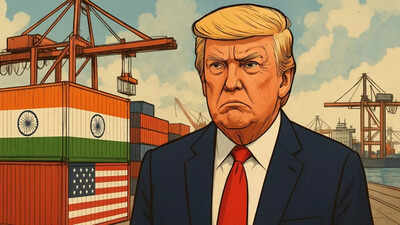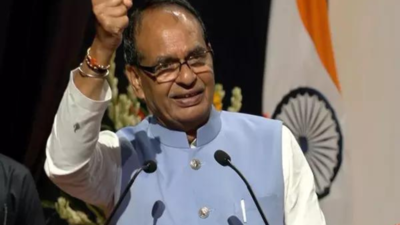Explained: How will Donald Trump’s tariffs impact India’s exports to US? These sectors will be the hardest hit

US President Donald Trump-led administration has notified that 25% additional tariffs on India’s exports to the US will be effective August 27. This takes the total tariffs applicable on India to 50%, among the highest faced by major countries doing trade with the US.The US Department of Homeland Security announced in its draft order that higher duties will be imposed on Indian goods that are “entered for consumption, or withdrawn from warehouse for consumption, on or after 12:01 am eastern daylight time on August 27, 2025”.
How will Trump’s 50% tariffs impact the Indian industry? Which sectors will be the most hit? We take a look:
Sector-wise impact of US tariffs on India
According to CRISIL, “The imposition of higher tariffs by the US will significantly impact micro, small and medium enterprises (MSMEs), which account for as much as ~45% of India’s total exports.”“Of the five sectors expected to see meaningful impact, gems and jewellery has the highest exposure to the US at ~$10 billion. While we expect export volumes to contract, the impact may not be fully reflected in revenue terms because of a likely runup in gold prices and sustained domestic demand,” it says.
- The removal of trade preferences under GSP will significantly impact sectors constituting approximately 25% of India’s US exports, particularly textiles, gems and jewellery, and seafood industries.
- Small and medium enterprises, which dominate these sectors with over 70% share, will experience substantial difficulties. The chemical sector, where SMEs hold 40% market share, is also expected to face significant challenges.
- In Surat’s gems and jewellery industry, which controls over 80% of diamond exports, MSMEs will experience adverse effects from the tariff implementation, says CRISIL. The US, being a significant consumer of Indian diamonds, receives approximately one-third of exports, whilst diamonds constitute more than half of the nation’s gems and jewellery exports.
- The seafood industry’s small enterprises face challenges with the newly imposed 50% tariff, particularly when competing against Ecuador. The latter’s geographical proximity to the US market, combined with a considerably lower 15% tariff, creates an uneven playing field.
- The chemical sector encounters robust competition from Japanese and South Korean manufacturers, who benefit from reduced tariff rates.
- The automotive components sector anticipates a slight negative impact, considering the US market represents only 3.5% of India’s total production. Small and medium enterprises that supply parts to major exporters dealing with the US market will experience setbacks. This impact is notably significant for suppliers of gearbox and transmission equipment components, which represent 25% of India’s automotive parts exports and maintain substantial US market exposure of approximately 40%.
- Certain industries remain protected at present. For example, pharmaceutical products, constituting 12% of US-bound exports, are presently free from tariff impositions.
- The US tariff implementation will impact $19 billion worth of exports across textiles, chemicals, seafood and auto components sectors, with a portion facing potential risks. Nevertheless, the anticipated $10 billion growth in the domestic market for these sectors is likely to partially offset the negative effects, says CRISIL.
- For steel industries, the US tariffs are predicted to have minimal impact on MSMEs, as these enterprises primarily focus on re-rolling and long product manufacturing, whilst the US predominantly imports flat products from India. Additionally, the US represents merely 1% of India’s total steel exports.
Pushan Sharma, Director, Crisil Intelligence says, “Partial absorption of the increased product prices due to higher tariffs will put pressure on MSMEs, squeeze their already-slim margins and pose a material challenge to their competitiveness. For instance, those into readymade garments are expected to lose ground in the US as the tariff increases to 61%, including 50% additional ad valorem duty, compared with peers in Bangladesh and Vietnam tariffed at 31%. The Tirupur cluster, which accounts for over 30% of India’s RMG exports, will be severely impacted as ~30% of its exports are to the US.”According to a GTRI analysis, following will be the impact of high US tariffs on Indian exports:
- Auto component exports valued at $3.4 billion now face 25% duties, whilst remaining auto exports of $3.2 billion encounter 50% tariffs.
- US-bound shrimp exports ($2.4 billion, comprising 32% share) now subject to 60% total duties, putting Visakhapatnam aquaculture at substantial risk.
- The gems and ornaments sector ($10 billion, with 40% US market) faces 52.1% duties, endangering employment in Surat and Mumbai.
- Clothing and textile shipments ($10.8 billion, constituting 35% share) hit with 63.9% duties, impacting Tiruppur, NCR and Bengaluru centres.
- Carpet exports ($1.2 billion, 58.6% share) and handicraft items ($1.6 billion) may struggle as Turkey and Vietnam secure US buyers.
- Agricultural produce ($6 billion) including Basmati, spices and tea affected by 50% duties, whilst Pakistan and Thailand gain advantage.
- Metal exports comprising steel, aluminium and copper ($4.7 billion) plus organic chemicals ($2.7 billion) face duties exceeding 50%, affecting small enterprises.
- Industrial machinery ($6.7 billion) and vehicle exports ($2.6 billion) to lose ground as US importers favour Mexican, European and Asian alternatives.





